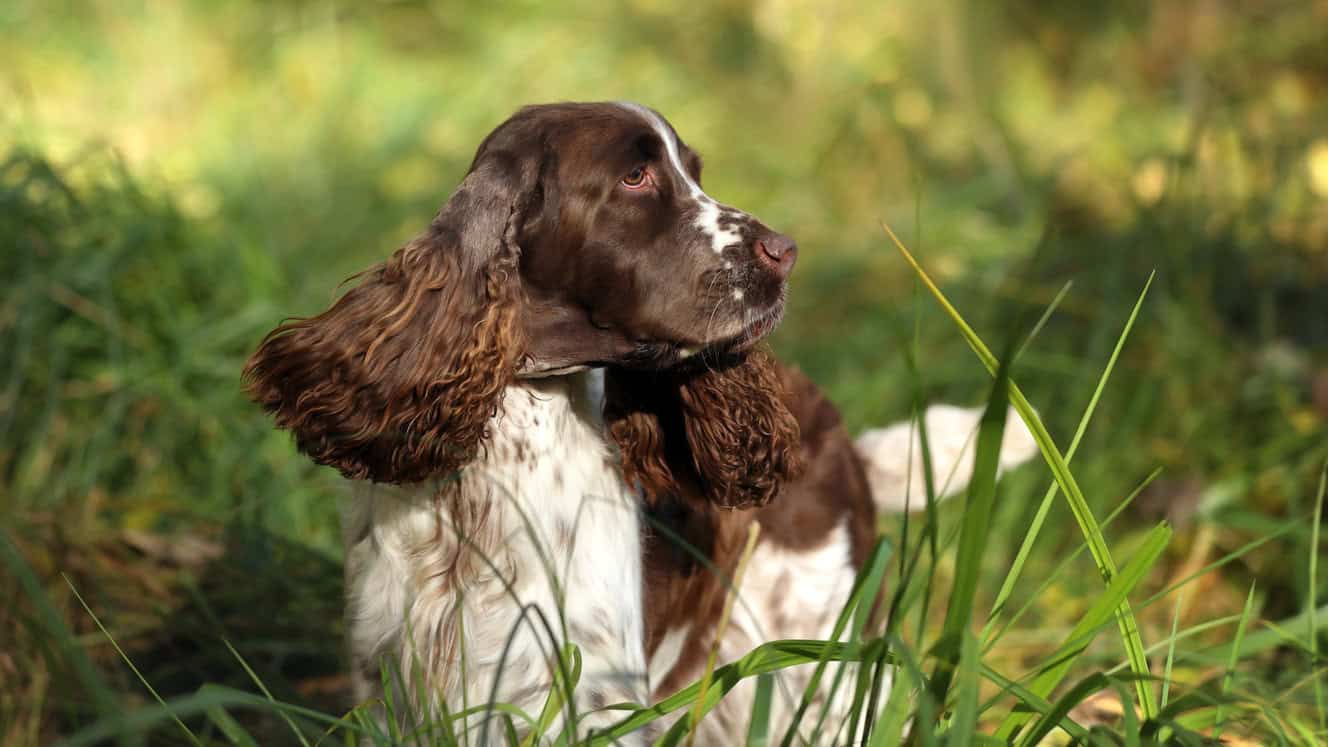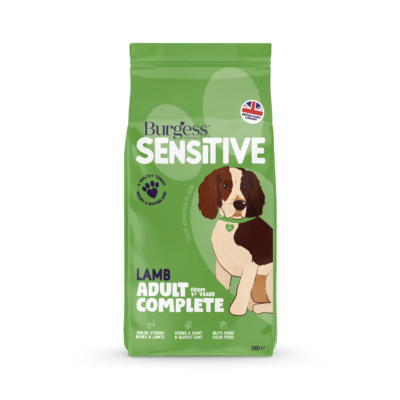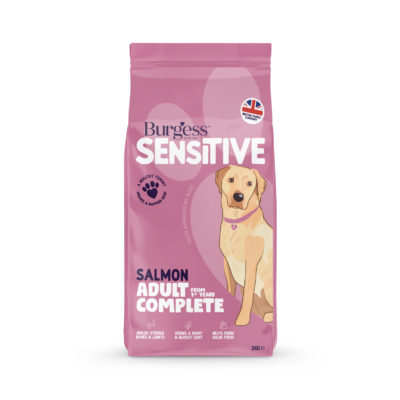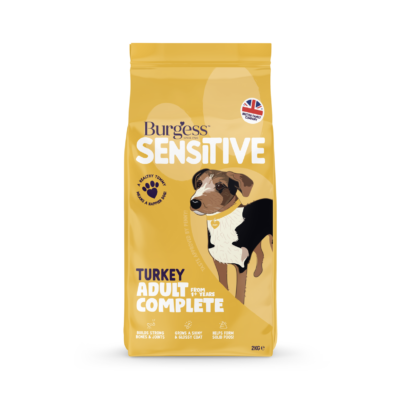
Cheerful, attentive, with boundless energy, Springer Spaniels can make excellent family pets, as long as you do lots of research to see if this athletic breed is right for you.
Pet Plan says: “Due to their kind and gentle nature, Springer Spaniels are consistently ranked as one of the UK’s most popular dog breeds. Friendly, loyal and intelligent, the Springer Spaniel makes for a great family pet that will live very happily in a busy household alongside other pets. However, their intelligence and energetic nature means they need plenty of mental stimulation and physical exercise to keep unwanted behaviours at bay.”
Why they’re called ‘Springers’
With their beautiful, almond-shaped eyes, drooping, silky ears and feathery tail that wags unfeasibly quickly, The Kennel Club reveals that Springer Spaniels earned their name by their practice of 'springing' forward to flush game out of the undergrowth. Described as “compact, strong, merry, active and raciest in build of all British land Spaniels,” this medium-sized breed comes in liver and white, black and white and tricolour.
“Spaniels came from Spain in the 1600s and in 1902 the Kennel Club recognised the breed and they were divided by height and what they were doing in the field,” explains rehoming charity Just Springers Rescue. “Smaller Cockers were mainly used for cocking Woodcock and Springers were used mainly as flushing or springing larger game birds such as partridge and pheasant, hence the name English Springers. Other Spaniel breeds such as the Sussex, Welsh, Clumber etc came about roughly at the same time, being mainly bred to suit the area and terrain they lived in.”
What’s the best food for a Springer Spaniel puppy? >>
There are two types of English Springers – the Show Type and the Working Type. Just Springers Rescue describes the Show Type has having a fuller, silkier coat, more domed head, longer ear flaps, larger bones and a slightly more placid temperament. By contrast, the Working Type are lighter boned, have smaller ears, a shorter, tougher coat and are usually more energetic.
What’s the best food for Working Springer Spaniels? >>
Dogged detectives
Whether Show or Working, these are dogs that like to have plenty to do – particularly if it involves using their incredible sniffing skills and innate drive to seek stuff out.
Just Springers Rescue says: “Springers are a highly intelligent breed who love working in one form or other.” It’s no surprise that many Springers have carved out successful canine careers working with agencies such as Border Force to sniff out illicit goods such as drugs, explosives and tobacco, and as Medical Detection dogs, checking samples for cancer and other diseases.
With a combination of high energy and high intelligence, Springers rely on their human to provide them with a busy and enriching life, or problems can develop. “Springers being so full of energy need regular free exercise as they love to run and get as dirty as possible. They need a full, active life, or they will start to entertain themselves by getting up to mischief,” is the sage advice from Just Springers Rescue.
Springer Spaniel health concerns
While generally a healthy breed, there are some health concerns to consider. Insurer Pet Plan says: “Like all breeds, English Springer Spaniels are prone to certain conditions, and choosing a reputable breeder or rehoming organisation should be the first step to having a happy and healthy dog.”
Health issues to note include hip or elbow dysplasia. This develops when the bones that form the hip or elbow joint develop abnormalities in the cartilage that lines the surface of the joint or structures around it, often leading to arthritis. Cruciate ligament disease can also affect Springers. This is where the ligament slowly frays and gets weaker and can get worse over time, requiring surgery.
Pet Plan adds: “Springer Spaniels are susceptible to various forms of skin problems, often involving the skin within the ear. The ear canal can become irritated by parasites, allergies or infections, and Springer Spaniels are particularly prone to getting grass seeds lodged in the ear canal.”
What’s the best food for Springer Spaniels? >>
Dogs Trust advises: “Whatever the breed, all dogs need basic preventative health care like vaccinations and flea and worming treatments. You’ll also need insurance to help cover the cost of vet bills.”
Understanding what makes your English Springer Spaniel tick will help you give them everything they need to love life! Read on to discover more about:
- ENGLISH SPRINGER SPANIEL PERSONALITY PROFILE
- IS MY HOME SUITABLE FOR AN ENGLISH SPRINGER SPANIEL?
- HOW MUCH EXERCISE DOES AN ENGLISH SPRINGER SPANIEL NEED?
- WHAT SHOULD I FEED AN ENGLISH SPRINGER SPANIEL DOG?
- HOW MUCH GROOMING DOES AN ENGLISH SPRINGER SPANIEL NEED?
- WHAT’S THE BEST WAY TO TRAIN AN ENGLISH SPRINGER SPANIEL?
- GETTING AN ENGLISH SPRINGER SPANIEL
ENGLISH SPRINGER SPANIEL PERSONALITY PROFILE
Springer Spaniels are a happy-go-lucky breed who get on well with everybody,” states Pet Plan. “Their attentive and affectionate nature means they tend to be good with children, and their fun-loving nature makes them a great playmate for the whole family. These people-loving dogs will welcome strangers and expect attention from everyone!” With such enthusiastic dogs, teaching them to make a polite hello is essential!
“English Springer Spaniels are happy, playful and energetic, adds veterinary charity PDSA. “They make good family dogs; they’re well behaved, love to be kept involved in family activities and get along well with children and other household pets.”
Springers want to be the centre of your world
Describing Springers as: “A lively, energetic dog best suited to an active lifestyle,” Your Dog notes that the breed “adapts to urban life but will thrive in the country and loves the chance to go for long jaunts at a moment’s notice, loves human company and craves his owners' attention,” adding: “These dogs are innately happy and are incredibly loyal, friendly, and affectionate, especially towards their human family. They are very sociable and love to be included in family activities.”
If having a devoted doggy pal is exactly what you’re after, then a Springer could fit the bill. “Who wouldn’t want a loyal dog, and spaniels are loving and loyal to the extreme,” say the breed experts at rehoming charity Spaniel Aid, adding: “If you don’t want to share your personal space, bathroom visits and sofa, then another breed may suit you better.”
Also be aware that this is a dog that enjoys everything about being outdoors – especially if it involves mud and water. English Springer Rescue says: “Practically every Springer you meet will possess an instinctive love of water (except at bath time!) and is attracted to any body of water – be it pond, lake, stream or sea. Muddy puddles will probably hold a particular fascination for him.”
Crate training a Springer Spaniel puppy – make it their special place >>
Whatever the breed, every dog is unique
While each breed has certain identifiable traits, it’s important to remember that every dog is unique.
Dogs Trust says: “Even if you think you know about Spaniel breeds, it’s important to remember that every dog has their own personality. Just like you, every dog is an individual with their own personality and prior experiences. As dogs grow from puppies, they learn all about the world. They develop their own likes and dislikes and learn to respond to situations in different ways. For example, some dogs might like meeting other dogs, and some may not. Some might like new experiences and others may need to go slowly.”
Want just YOUR dog to come when you call them? Choose their name wisely! >>
IS MY HOME SUITABLE FOR AN ENGLISH SPRINGER SPANIEL?
To create a perfect canine/human partnership, it’s vital to think about what kind of energy and temperament you’d like your four-pawed friend to have so you’re a good match for each other – and that you can provide a suitable environment.
The Kennel Club recommends that Springer Spaniels are happy in any size house, in a town or country setting, as long as it has a large garden.
However, if you’re extremely house proud, this may not be the right dog for you.
“Do you have a spotless house with cream carpets, an award-winning garden and a Smart car? Then a Spaniel may not be for you,” advises Spaniel Aid. Describing Springers as ‘mud magnets’ the charity explains: “Spaniels were bred to work in the field and they like to run through mud and puddles, dive into hedgerows and bounce through long grass, so expect them to get muddy and collect vegetation in their ears. However hard you try; you can expect some of that mud to be tracked through your home.”
Which breed of dog is the right fit for you and the place that you live? >>
Springers can make great playmates
“Attentive and affectionate, English Springer Spaniels make wonderful family pets and do well with children,” says Pet Plan. “However, Springers can get over-zealous when it comes to playtime meaning they can get a bit too boisterous for smaller children. As with all dog breeds, it’s important to supervise your Springer Spaniel around children to make sure everyone is safe and happy.”
The family dog – making it work for pets and children >>
As for getting along with other pets, Springers will generally make friends with most other animals, apart from the feathered variety. Pet Plan states: “Despite their working background, Springers tend to get on well with other pets, apart from birds who they will instinctively hunt.”
Can cats and dogs be friends? >>
Due to their unwavering dedication to their human, Springers hate being left alone and need a home where someone is around most of the time. “This need for human companionship can also results in spaniels developing separation anxiety when left alone. Please think carefully about how you would manage a dog that needed constant companionship,” says Spaniel Aid.
It’s important that your Springer is never left alone for more than four hours, but even this may be too much for some dogs to handle. You’ll need to teach them that it’s OK to be alone for very short periods from a young age.
“Springer Spaniels are fundamentally social dogs. Leaving them alone for long periods may cause separation anxiety as well as destructive and disruptive behaviours,” adds Pet Plan. “They are happiest in the company of their owners or other pets (as long as they are properly introduced). If you do have to leave your Springer alone for a few hours, make sure they have plenty of toys to keep them occupied and consider having someone come to check in on them.”
HOW MUCH EXERCISE DOES AN ENGLISH SPRINGER SPANIEL NEED?
If you’re an active type who’s happy to spend lots of time outdoors whatever the weather, then a Springer Spaniel could be your perfect canine companion.
“A single walk to the local park is rarely enough for a Spaniel, you will need to be prepared to go out in all weathers, two or three times a day,” says Spaniel Aid.
“Springers need plenty of walks due to their high energy levels, so will need an owner who’s prepared to give them over two hours of exercise per day,” advises PDSA. Springer Spaniels also need lots of playtime and will enjoy training sessions and games to challenge them.
How much exercise do different dog breeds need? >>
“Springers are highly intelligent and energetic and need plenty of exercise, stimulation and variety in their lives,” adds Pet Plan. “Springers also love to swim, and this is a great way for them to keep fit and protect their joints. Springer Spaniels are always raring to go and excel at agility training, where they can expend some energy and show off their new tricks at the same time.”
“Their intelligence and athleticism make Springers ‘all-rounders’ perfectly suited to owners who want to take part in canine activities, such as obedience, agility, tracking, and so on,” observes Your Dog. “Once adequately exercised, they are happy to curl up on the sofa at the end of the day with their owners.”
WHAT SHOULD I FEED AN ENGLISH SPRINGER SPANIEL?
Burgess in-house vet, Dr Suzanne Moyes MVB MRCVS, who oversees recipe development and product production, advises: “When choosing food for Springer Spaniels, it’s essential to bear in mind that the optimum diet for your dog is one that supplies the correct number of calories and balance of nutrients for their life stage and lifestyle. This means calculating the nutrient content and dietary components such as protein, fat, carbohydrate and vitamins and minerals required. For example, a Working Springer that’s on the go all day will require a higher protein food with balanced carbohydrates for energy, compared to a Springer Spaniel who’s a family pet. All Burgess Dog Food is a complete food. This means, whatever variety you choose for your Springer, it will contain all the nutrients they need in the correct balance.”
The benefits of feeding a diet specially developed for a sensitive digestion
And, as Springers Spaniels can be prone to skin problems, choosing a food that’s specially designed for dogs with sensitivity issues could be beneficial.
Dr Moyes adds: “Dogs who suffer from skin issues or allergies need sensitive dog food that’s made without many ingredients known to cause irritation. These ingredients can include beef, eggs, dairy, wheat, maize, and soya. For many canines with skin issues or allergies, switching to a sensitive or hypoallergenic variety, depending on what your vet recommends, can make a world of difference to them.”
Your Springer will also benefit from feeding a variety of food that’s designed to meet their nutritional requirements throughout their life. Puppies need extra energy and other nutrients to support rapid growth. For adult dogs, providing a nutritionally balanced, complete diet will help keep them in tip top condition during the prime of their life. Many older dogs develop specific conditions, such as arthritis – some of which can be eased by feeding a diet designed just for them.
“Springers love to chew so dry food is recommended,” says Pet Plan. “This will also help to keep their teeth clean and healthy.”
How much to feed your Springer
“The amount of food a Springer Spaniel needs depends on their age, size, activity levels, fitness and weight,” advises Dogs Trust “You can use the information on dog food packets as a guide, taking your dog’s individual needs into account. Your dog's body condition is helpful for deciding how much food to give your dog. You can find more about body condition scoring from the World Small Animal Veterinary Association (WVASA). If you’re not sure, ask your vet for advice.”
Split their daily ration into two portions and feed your Springer Spaniel at similar times every day as they like routine, remembering to leave a gap between eating and exercising. If you give your dog the occasional treat or use treats for training, remember to take this into account and reduce their daily allowance. Treats shouldn’t make up more than 10% of their daily calorie intake as this can unbalance their diet.
Human food that you should never give to dogs >>
HOW MUCH GROOMING DOES AN ENGLISH SPRINGER SPANIEL NEED?
If you have a Springer, then you’ll need to enjoy grooming as these dogs, with their predilection for dashing through undergrowth and splashing in muddy puddles, require quite a lot of it!
“Springers have a double coat meaning they have a shorter, insulating undercoat and a long, wavy top coat,” explains Pet Plan. “To maintain a healthy, tangle-free coat, brush your Springer Spaniel two or three times a week, paying special attention to their feathery ears, chest and legs. Also use grooming time to check for lumps and bumps, as well as any ear problems which Spaniels can be prone to.”
“Due to his feathered coat a Springer requires a lot of grooming. Grass, twigs, seeds, and other debris are easily picked up in the coat. A Springer needs a good daily brush through. If knots and tangles aren't tackled promptly, they will form painful mats,” advises Your Dog.
“They’re also likely to need professional grooming,” adds Dogs Trust. “To help your dog feel comfortable with handling and grooming, introduce it in a positive way, one step at a time. Teaching your dog to feel relaxed and confident will make grooming more enjoyable for everyone.”
Regular teeth cleaning is also important to help to prevent plaque and tartar from building up and keep gums healthy.
WHAT’S THE BEST WAY TO TRAIN AN ENGLISH SPRINGER SPANIEL?
When it comes to training a Springer Spaniel, you’ll have a highly intelligent student, which doesn’t come without a few challenges!
“An intelligent dog is more easy to train, but a bright dog can test your patience as they devise new ways to wreak havoc, and learn from a single encounter, advises Spaniel Aid. “Spaniels are a very intelligent breed. They need to keep their brains active, and they need an owner who understands that, and is prepared to offer stimulation and enrichment activities throughout the day.”
“Eager to please and highly intelligent, Springers tend to be easy to train,” states Pet Plan. “Food is a great motivator so be sure to have some training treats at the ready. This playful breed will also respond well to toys as a motivator. Springers are easily bored so a long, repetitive training session will be counterproductive. Keep sessions to five to 10 minutes at a time.”
“It’s all about positive learning,” advises Dogs Trust. “Find out what your dog loves so you can use this to reward them after a success. Whether it’s treats, toys or lots of praise, training with rewards is the best way for your dog to learn. As dogs are clever animals, they need suitable mental and physical exercise so that they don't get bored. Learning useful life skills such as recall, loose lead walking and settling are just as important. This ensures that you and your dog can spend enjoyable time together, both at home and out and about.”
For expert advice and practical training guidance, visit Dogs Trust Dog School >>
GETTING AN ENGLISH SPRINGER SPANIEL
“Where you get a dog from can have a big effect on how healthy and happy it is for the rest of its life,” advises PDSA. “From spring 2020, third-party puppy sales will be banned under Lucy's Law, meaning if you are looking to buy a puppy you will need to deal directly with the breeder. This means you will not be able to buy puppies from shops or anyone who isn’t the breeder, making it safer for both you and your puppy. If you’ve chosen to buy a puppy from a breeder, we’d recommend a member of the Kennel Club Assured Breeders Scheme. These breeders must follow higher standards and therefore your puppy has a better chance of being happy and healthy.”
The comprehensive puppy checklist >>
Alternatively, there are a number of rescue organisations around the country including Dogs Trust, English Springer Rescue, Spaniel Aid, Just Springers Rescue, Cocker & English Springer Rescue, and South Yorkshire English Springer Spaniel Rescue who would love to hear from you. Staff will seek to match you with the right dog for your home and lifestyle and provide you with support and useful information about the breed. By choosing a rescue English Springer Spaniel you’ll be giving one of these energetic, loving dogs a second chance at a happy and fulfilling life.
The best breed of dog is rescue >>
Need more advice?
If you’re at all unsure about the best way of feeding your dog or have any concerns about specific nutritional requirements, ask your local veterinary practice for advice. You can also call our expert team, available 9am-5pm, Monday to Friday, on +44 (0)1405 862241 who’ll be happy to help. Alternatively, use our online contact form to get in touch.
CARE MORE Find lots of useful advice on caring for your dog from Burgess, the pet experts >>
SOMETHING TASTY FOR EVERY DOG
Every dog deserves a first-class dinner from puppy to adult and senior. Burgess Pet Care is a British, family-owned company and all our dog foods are made at our own factory in the heart of Yorkshire, using only ingredients that meet our stringent specifications – locally sourced wherever possible to support British farmers
We’ve also developed foods to meet the specific nutritional needs of sporting and working dogs, Greyhounds and Lurchers and dogs with sensitivities.
All Burgess dog food is a complete food. This means, whatever variety you choose for your dog, it will contain all the nutrients they need in the correct balance. By choosing Burgess dog food, you know you can feed your canine companion with complete confidence.
Why choose Burgess Sensitive? Because it’s super-premium nutrition for dogs with sensitive skin at an affordable price!
Burgess Sensitive is made without ingredients that are known to cause common food allergies that may lead to skin issues. Dogs tend to be allergic to proteins (meat or dairy), most commonly beef. Some dogs will be allergic to other ingredients, such as wheat, eggs and soya. That’s why none of these ingredients are included in Burgess Sensitive recipes, which are available for puppies, adult and senior dogs.
Good to know
- COMPLETE NUTRITION Each of the recipes in the Burgess Sensitive Dog Food range are complete, providing all the nutrients dogs require in the right proportions.
- PORTION CONTROL With dry food, it’s easy to measure out the right sized portion to help your dog maintain a healthy weight.
- HEALTHY AND SAFE The thorough cooking process ensures that any harmful bacteria, such as salmonella, and viruses are destroyed, and the dry food stays fresh inside the pack.
- TEETH FRIENDLY Dry dog food has the added benefit of exercising your dog’s chewing muscles and provides a mild cleaning effect on the teeth.
- MADE IN BRITAIN Crafted at Burgess Pet Care’s own factory in the heart of Yorkshire, Burgess Sensitive Dog Food contains high-quality ingredients that meet stringent specifications, locally sourced wherever possible to support British farmers.
With a whole host of *5 STAR REVIEWS*, our customers have told us:
* “Only food my puppy’s stomach can tolerate at the moment. Love this food!” * “Works well for my puppy and has made a great difference to his digestive system.” * “My doggy loves his food, and it is really good quality. Very happy with the product.” * “My dogs love it and have beautiful shiny coats.” * “My dog seems to like the senior food and it appears to have helped settle his sensitive stomach.” * “My two dogs enjoy the taste of the food. They seem happy and have more energy and bounce. Their coats are glossy and sleek. The end products are easier to pick up. After trying lots of other foods – I'm impressed.” *
Lamb? Turkey? Salmon? Your dog can try them all with our Burgess Sensitive Bundle >>
Is your dog a Burgess dog? Join the Burgess Pet Club for exclusive offers and rewards.
If you found this interesting, you may also like:
DOG DAYS From puppy to adolescent, through to adult and senior, as your dog goes through different stages, their exercise and nutrition needs change. Find out how to help them stay happy and healthy every day of their lives...
FLYING PAWS AND ROUNDS OF APPLAUSE – WOULD YOUR DOG BE GOOD AT DOG AGILITY? Do you have a dog that’s simply bursting with energy? Would you like to be involved in an activity together, that involves reward-based training, competing in shows and hanging out with lots of other lovely dogs and their owners? Then dog agility could be just right for you and your canine chum.
ARE YOU AND YOUR DOG GOOD SPORTS? One of the many things that dogs and humans have in common is that we both benefit from physical activity. While going for a long country walk is one way to do it, there is nothing like a fun, teamworking activity to keep your dog fit, mentally stimulated and to build that special bond between you.
OPEN UP YOUR EYES TO YOUR DOG’S WORLD Understanding how your four-pawed pal interprets the world through their five senses can help you provide them with the best, most enriching life.
FUN AND GAMES IN THE DOG PARK Going to the park is the highlight of many dogs’ day as it’s a chance for canine chums to enjoy a meet and greet and dash about with their best buddies. However, not every dog-to-dog interaction goes to plan and there are definite rules of the game to be followed.
BACK TO DOG SCHOOL Training is an essential part of dog ownership and, whatever age your dog is, training should be part of their regular routine.
BEST BEHAVIOUR – HOW TO TRAIN YOUR DOG TO MAKE A POLITE HELLO Most dogs get really, really excited when they meet a friendly human on their walk – Jumping up, twirling and barking. While this can be cute when they’re a small puppy, it’s not so good when they grow into their paws and jump all over the person in question!
BACK SOON All dogs benefit from learning to manage being on their own for short periods. Otherwise, if you have to leave your dog and they aren’t used to it, it will be very stressful for them.
HOW TO TEACH YOUR DOG THAT IT’S CHILL OUT TIME Are you struggling to find your dog’s off button? While some canines are natural couch potatoes, others need a little encouragement to learn to settle down and be calm. Our expert step-by-step training plan can help.
GIVE THE DOG A CHOICE As humans, our lives consist of choices. Yet, how much of a say do our dogs have about what they do, how they do it and when? Could letting them make their own decisions really make them happier?
DOG TRAINING MYTHS BUSTED All sorts of people have opinions on the best ways to train a canine – but it’s essential to only take advice from expert, trusted sources.
DOG BEHAVING BADLY? What’s the thing that your dog does that you find baffling, frustrating or even downright annoying? Barking at people walking past the window, ripping up the post, digging holes in the lawn, eating food out of the bin or running off with your slippers?
ARE YOU READY FOR A DOG? Taking on a dog is a huge decision. It requires money, time and commitment. Here are some of the things you’ll need to consider...
PET INSURANCE EXPLAINED Can you get pet insurance for pre-existing conditions? Can you get pet insurance for older pets? Can you get multi-pet cover? We answer some of the most commonly asked questions to help you make an informed decision about pet insurance.
DOGS EAT GRASS – BUT WHY? There are all sorts of theories as to why they do it – from fulfilling their natural omnivore instinct to improving digestion or simply because they enjoy the interesting taste and texture – but no one’s exactly sure why.
COULD YOUR DOG BE ALLERGIC TO YOUR HOUSE? Our four-legged friends can be allergic to all sorts of things, from chemicals in cleaning products to pollen, dust, fleas and even smoke from cooking.
FOOD ALLERGIES UNDER INVESTIGATION Itchy skin, upset tummy, weight loss? These can all be symptoms caused by diet. If you suspect food could be the issue, where do you start?
DID YOU KNOW THAT OUR PETS CAN SUFFER FROM HAY FEVER TOO? While the cause of pollen allergy is the same in pets as it is in humans, the signs that your pet is suffering from hay fever can be a little different.
FAD DIETS – SHOULD DOG OWNERS BE WORRIED? Raw, grain free or home-cooked? The range of options for feeding your dog seems to be ever expanding. But what do animal nutrition experts have to say about it?

















